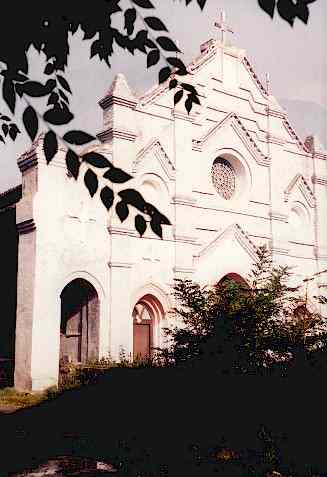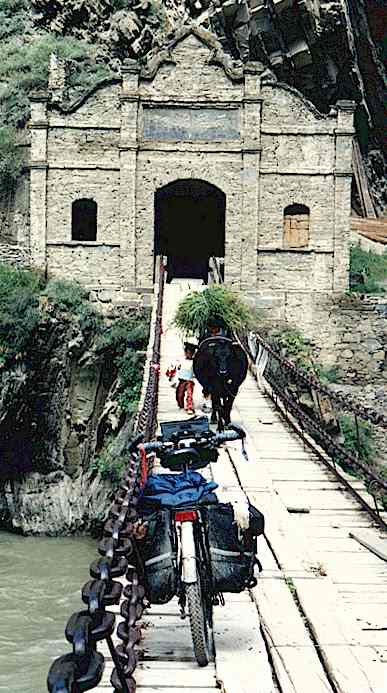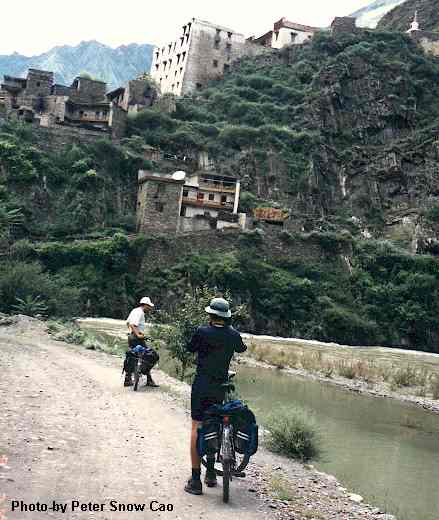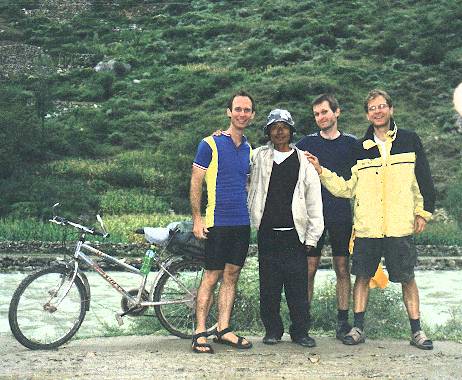China Cycling Travelogues
Do you have a China cycling travelogue you would like
to share here?
Contact us for details.

"Cycling to Danba in Western Sichuan, China"
Part 5
Copyright © Peter Snow Cao, 2001.

The next day we return to the temples and church for a closer look. Four girls at the Buddhist temple are dressed to kill, and shyly pose for Mark’s camera. Afterward, he chastises them for littering the joss stick wrappings on the road. The Islamic Temple sits on a hill opposite the main part of town. Adjacent to the temple is a government party school, located there to no doubt keep an eye on things. The grounds are immaculate, and we note there are spotless dormitory rooms available. The resident imam greets us politely and tells us about the four enormous trees in the courtyard. They were saved from the Cultural Revolution by ardent supporters who vowed to cut anyone’s head off that tried to harm the trees.

As we head out of town, we glance down at the river and spot another chain bridge leading to the other side. We descend to investigate, and discover one of those unique places where if you just sit and wait happenings come to you. None of it was extraordinary, but all it afforded a glimpse into the average person’s life. A woman with a huge bundle of hay in a basket and a small child carrying a smaller version of the same coaxing a massive ox across the bridge with a switch. School had just let out at noon and the kids came dashing along in groups of three and four laughing and playing. Each one a picture of innocence.
The driver from last night warned us that the road deteriorates dramatically as we approach Danba, our groups final destination. About half way there, we cross the county line and the pavement abruptly ends. However the good weather and interesting landscape keeps our spirits high. The river continues to grow by leaps and bounds, and as a result of the enormous amount of rain we have had, has swollen to an all time high. Along the way, I have been joking with Rainer that these rivers would make excellent rafting trips. We come to a particularly violent section with several multi-meter waterfalls cascading in a roar and tells me to be sure to send him a photo of me before I get in the boat.

Stupas and footbridges dotting the roadside provide a ready excuse to take a break and chat. Off in the distance, we spot a mini-Potala across the river on a hill. Rainer and Mark go across the bridge on foot to investigate while I remain behind to watch the bikes. A woman at the riverside washing clothes discreetly keeps an eye on me. The town is from another dimension, and judging by the way the locals avoid us, apparently rarely receives visitors. When it is my turn to go, I am immediately drawn to the fortress overlooking the town. It is a lamasary built about 500 years ago and can house 50 lamas. It is now empty save one lama and two old caretakers. The lama warmly welcomes us and gives a tour of the main hall, but asks us to refrain from taking pictures. The walls are painted with 500 year-old figures from Tibetan Buddhism and the lama tells us their names. Some are very faded, while others are still distinct. The entire building has the feel of something great, long since neglected and badly needing TLC. I shyly ask whether the Chinese government has caused them any problems, and he tells me that no, except that they used to get some financial assistance, but not any more. This is the reason why the he is the only one left there. The rest of the lamas are up in the hills working to earn a living.
As I start to leave, I thank him for his time, and then think to ask about a donation box. He says that there is one, but it is better to write it in the book, and goes to fetch it. I had planned on giving 20 yuan, but when he returns, I change my mind and offer 100 yuan. He is genuinely thankful and invites me to his private quarters to receive a red string for good luck. In the courtyard on the way, a peasant woman carrying a basket on her back presses 20 yuan into the lama’s hand. He tries to refuse, but she won’t hear of it.
The lama’s quarters are located in the corner of the outside wall with windows overlooking the village and the river. It is a wooden structure with a low narrow ladder leading up to the second story and I bump me head. Inside his bedroom are two low beds with a narrow table between and a bowl with apples sunk inside the table. On the walls are two large pictures of the Dali Lama and a poster with enlarged prints of a 100-yuan note. Not sure whether I should say this or not, I tell the lama I have shaken hands with the Dali Lama in India but he doesn’t seem surprised. He laments that he will probably never get to see him.
On the way out, the lama presses three apples and red strings into my hands for each of us. Rainer wraps it around his wrist, while Mark ties it around his handlebars. The lama invites us to spend the night, but we opt to press on to Danba.
 As the afternoon wears
on, the sky grows darker and it begins to rain lightly. The road has progressively
deteriorated and we are intently focused on getting to a comfortable place.
Another cyclist approaches from the opposite direction and I notice that
he is not the average Chinese cyclist. He is riding a small mountain bike
in an area where they are relatively rare, despite the hills, and has a
small bundle on the rear rack instead of the standard enormous baskets,
pig or other such farm produce. He is also wearing an unconventional hat,
and I am prompted to call out as he passes by. Rainer looks up in wonder;
he never saw him and Mark is out of sight ahead. The three of us stop and
immediately recognize each other for what we are… touring cyclists.
Xiao Yao is the first Chinese long distance cycle tourist I have met. He
is overjoyed to run into fellow cyclists-cum-masochists. He tells us in
lightening-fast Chinese about where he has been. He is from Hunan Province
and has spent the last twelve years wandering around China stopping to work
when he runs out of money. In his 35-day trip from Lhasa to Chengdu he spent
a total of 400 yuan (about US$50). He eats simple inexpensive food, sleeps
out or with local farmers much of the time. He carries photos and a notebook
with names of people he has met along the way. He also has a T-shirt pocked
with dozens of postal cancellation marks (stamps) that verify his story.
As the afternoon wears
on, the sky grows darker and it begins to rain lightly. The road has progressively
deteriorated and we are intently focused on getting to a comfortable place.
Another cyclist approaches from the opposite direction and I notice that
he is not the average Chinese cyclist. He is riding a small mountain bike
in an area where they are relatively rare, despite the hills, and has a
small bundle on the rear rack instead of the standard enormous baskets,
pig or other such farm produce. He is also wearing an unconventional hat,
and I am prompted to call out as he passes by. Rainer looks up in wonder;
he never saw him and Mark is out of sight ahead. The three of us stop and
immediately recognize each other for what we are… touring cyclists.
Xiao Yao is the first Chinese long distance cycle tourist I have met. He
is overjoyed to run into fellow cyclists-cum-masochists. He tells us in
lightening-fast Chinese about where he has been. He is from Hunan Province
and has spent the last twelve years wandering around China stopping to work
when he runs out of money. In his 35-day trip from Lhasa to Chengdu he spent
a total of 400 yuan (about US$50). He eats simple inexpensive food, sleeps
out or with local farmers much of the time. He carries photos and a notebook
with names of people he has met along the way. He also has a T-shirt pocked
with dozens of postal cancellation marks (stamps) that verify his story.
Xiao Yao just came from Lhasa, Qinghai, Gansu, and Yunnan proudly showing us his Yunnan Xishuangbanna bicycle license tag to prove it. Rainer is anxious to get the road conditions up into Qinghai and the two of them huddle over maps while I hold a raincape over their heads to protect map from getting wet. After 15 minutes, Mark returns to find us still talking like mad about routes and trips. He joins the foray and we continue until the rain makes us realize we have to get going. With a flurry of name and address exchanges and the obligatory photos, we reluctantly part company. There is a chance we will meet again in Chengdu as Mark and I have to take the fast way back in order to meet other commitments (namely a tour in Yunnan due to start in a few days). Xiao Yao warns us that the road ahead is pretty bad, and we push off in opposite directions.
The rain continues to fall harder and the landscapes become obscured from view. All our attention is on the road, now mostly mud, puddles and ruts from buses and trucks. We stop from time to time to ask about the distance to Danba, and the answer is always disappointingly further than we expect. Under a small overhang there is a group of locals waiting for the rain to slow down before dashing home, umbrella-less. They invite us to join them and the humble shelter is irresistible. The girl acts as spokeswoman, probably because she can speak Mandarin. She tells us she has been picking apples while the rest of the group has been working on the road.
We cannot wait any longer; there are still eight difficult kilometers to go, and the light is starting to fade. Back on the sorry excuse for a road, with mud-caked shoes. A temple that would ordinarily be worthy of a look-see is passed by without comment. We finally hit Danba; it is dusk, and paved roads never looked so good. The town is stretched along both sides of the Dadu River for several kilometers. The main part of town is across a wide bridge now closed to vehicle traffic using tall concrete walls with openings only wide enough to allow a bicycle pass through. From the other bank we are able to see scaffolding under the bridge in an apparent attempt to keep the bridge from collapsing.
After some hunting and negotiation, Rainer snags us a couple of deluxe rooms for 100-yuan (US$12) each. Given our rain-fouled mood, we are happy to splurge a bit. All three of us are wiped out, and after a brief dinner, hit the hay. This marks our last day as a trio as Mark and I have to return to Chengdu tomorrow. Rainer will continue west into Qinghai. Mark warns him to beware of groups of Tibetans as they may not all be on friendly terms. Both of us have heard stories of robberies. Rainer is a bit shaken, but resolves to continue regardless. The bus reportedly leaves at 6 AM so Mark and I set our alarms for 5 AM.
The next morning, it is pitch dark and Rainer bids us farewell dressed only in a pair of scant burgundy briefs and rubbing his belly, Chinese-style. Mark comments that this is a hell of a way to remember him.
On the hotel walls are pictures of 30 Tibetan fortresses in the hills around Danba that look stunning. I wish we had more time to explore.
Next: Cycling Trip to Danba, Sichuan: Day 6 Danba to Chengdu
Cycling to Danba: Part 1 | Part 2 | Part 3 | Part 4 | Part 5 | Part 6 | More Pictures
Bike China Adventures, Inc.
Home | Guided Bike Tours | Testimonials |
| Photos | Bicycle Travelogues
| Products | Info |
Contact Us
Copyright © Bike China Adventures, Inc., 1998-2012. All rights reserved.
